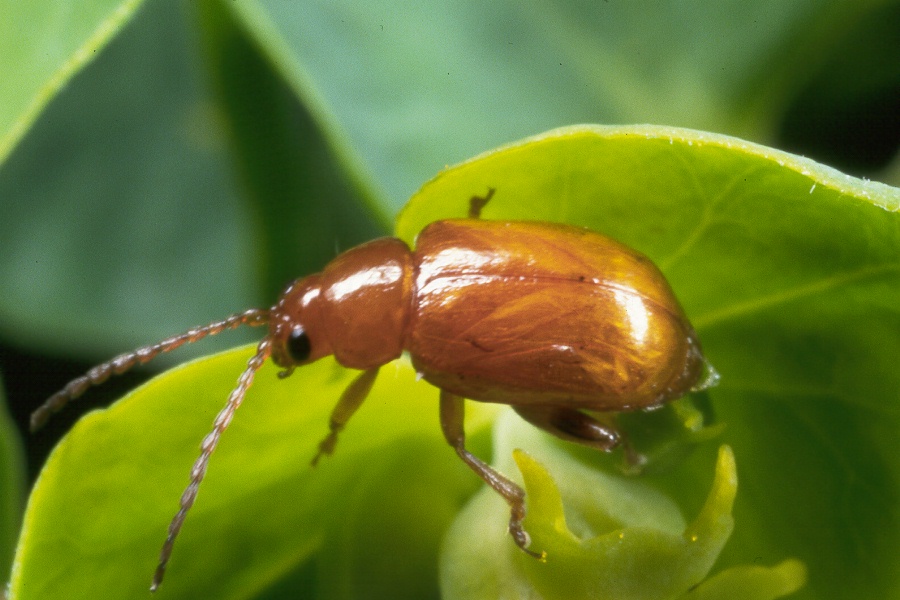Aphthona flava
Photos Beetles: [1] [2] [3]
Photo by Bob Richard, USDA-APHIS-PPQ.
Origin: Hungary and Italy (3).
Type of agent: Insect: Beetle: flea beetle (Coleoptera: Chrysomelidea)
Life cycle:
Over wintering stage: Larval inside the roots of young leafy spurge (1).
Egg stage: In June through early fall the eggs are deposited. They are deposited mostly on the stem of the plant, at or below the surface of the soil, and sometimes in or on the soil, while near the plant's stem (1).
Larval stage: July through early spring of the following year, the larvae are active. When the larvae are young they feed in/on the root hairs. When the larvae become older they become larger and they migrate to the larger roots. In order to see them, they must be viewed with a microscope. The larvae are of white coloring and are worm like when they are mature. At this stage they can be observed with the naked eye (1).
Pupil stage: From late spring to early summer pupation takes place in the soil (1).
Adult stage: In June through early fall the adults come out depending on the temperature of the day. The adults are like a flea beetle in appearace and activity. The size of an adult male is about 3.4mm (0.13in)long. The size of an adult female is about 3.6mm (0.14in) long (1).
Effect:
Destructive stages: The adults are destructive when their on the leaves, and the larval are the most destructive when there in the root hairs of young roots.
Plant species attacked: Leafy spurge (Euphorbia esula) complex.
Damage to host: It reduces photosynthesis and flowering ability. It reduces its ability to absorb moisture and nutrients, by feeding on the roots. Larval root feeding is the most important factor in spurge control. A lot of them reduce plant population (1).
Releases:
First introduced into the United States: 1985, Montona (1).
Now established in: Colorado, Idaho, Iowa, Minnesota, Montana, Nebraska, North Dakota, Oregon, South Dakota, Utah, Washington, Wisconsin, & Wyoming (1).
Habitat: Grasslands infested with leafy spurge that receive 46-51 cm of moisture per year (1).
Availability: A. flava is available free of charge from Montana County Weed Districts and biocontrol companies in some states (1).
Stage to transfer: Adult (1).
Redistribution: From late June through mid-August you collect the beetles. Release the beetles on leafy spurge plants. Roots that are frozen, which contain overwintering larvae, can be dug from the field during winter and can be kept frozen until several weeks before desired. Avoid distributing in areas with large populations of ants (1).
Comments: The first flea beetle to be released against leafy spurge in the U.S. was A. flava. It has had a spectacular effect around the Bozeman area of Montana. The A. flava flea beetle has numerous species. These species have similar habit and life cycles, although some have better adaptations for certain soils (2).
Links:
1)http://users.aol.com/prideedu/flava.htm
2)http://www.nysaes.cornell.edu/ent/biocontrol/weedfeeders/a.flava.html
3)www.co.stevens.wa.us/weedboard/htm_bio/aphthona_flava.htm
4)http://www.co.arapahoe.co.us/CM/Weed%20Control%20Program/leafy%20spurge.shtm
5)http://www.colostate.edu/Depts/CoopExt/Adams/weed/spurge_mgt.htm
6)http://www.npwrc.usgs.gov/resource/othrdata/Explant/euphesul.htm
7)http://www.wildflowers-and-weeds.com/weedsinfo/Euphorbia_escula.htm
8)http://www.ext.colostate.edu/pubs/natres/03107.html
9)http://www.bio-control.com/7b.asp
10)http://www.for.gov.bc.ca/hfp/noxious/a5.htm
Bibliography:
(1) Hansen, Rich. Aphthona flava. Available [Online] http://www.nysaes.cornell.edu/ent/biocontrol/weedfeeders/a.flava.html January 29.(2) Author Unknown, Aphthona flava. Available [Online]
http://users.aol.com/prideedu/flava.htm January 29.(3) Author Unknown, Aphthona flava. Available [Online]
www.co.stevens.wa.us/weedboard/htm_bio/aphthona_flava.htm May 03, 2001.
By: Cody O'Donnell, Forrest Lewton, Whit Smith 01/03
mtwow.org HOME Back to Biological Control Agents, by Weed